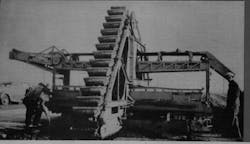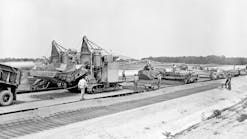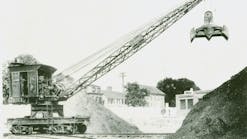Like so much else, machine-control technology relies heavily on electronics. But even before the advent of computers, control systems on early machines focused on automation in one form or another.
The machine shown is quite possibly the first construction machine of any kind to utilize automated controls. In the late 1920s, A.W. French & Co. offered a crawler-mounted unit that used the first known stringline control.
Called the Utility Grader, it consisted of a bucket loader traveling on rails mounted to a leveling frame, which was supported at each corner by a powered jack. The interchangeable rails could be shaped to any desired contour.
The bucket loader excavated material from the roadbed, and a reversible discharge conveyor carried spoil to the side for loading into trucks or windrowing at the roadside. The automated control was accomplished by means of pointers on the leveling frame that traced a roadside stringline to keep the business end of the bucket loader on grade.
The Utility Grader was designed for everything from rough earthwork to fine grading to shoulder work; it’s not known if the machine continued in production after Blaw-Knox acquired French in 1929.
Some 30 years later, Gurries Manufacturing and others introduced tractor-towed subgrade trimmers that used stringline technology, and the stringline system spread to self-propelled trimmers, slipform pavers, and motor graders. A report in the trade press said that even a small motor scraper was set up by a contractor for stringline control, but that’s another story.
The Historical Construction Equipment Association (HCEA) is a 501(c)3 nonprofit organization dedicated to preserving the history of the construction, dredging and surface mining equipment industries. With more than 4,000 members in 25 countries, activities include operation of National Construction Equipment Museum and archives in Bowling Green, Ohio; publication of a quarterly magazine, Equipment Echoes, from which this text is adapted, and hosting an annual working exhibition of restored construction equipment. Individual memberships are $32 within the U.S. and Canada, and $40 elsewhere. Information is available at www.hcea.net, 419.352.5616, or i[email protected].





